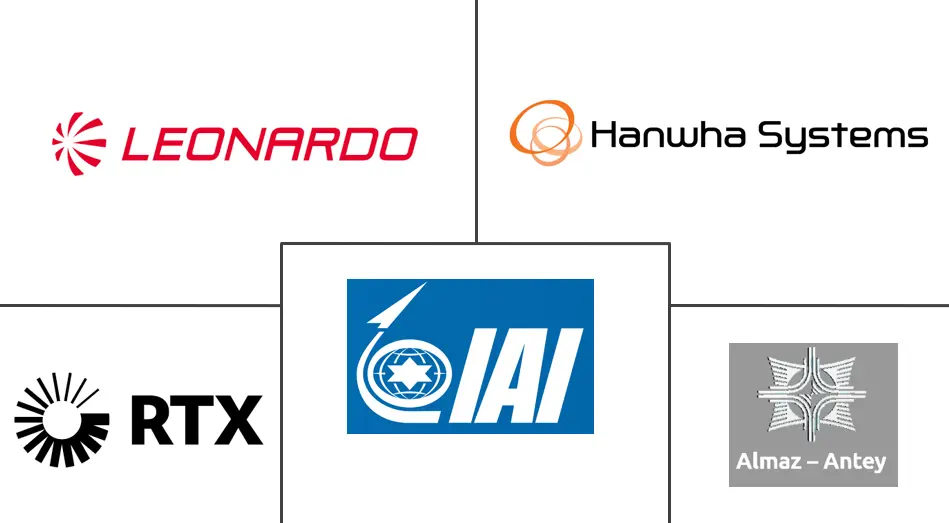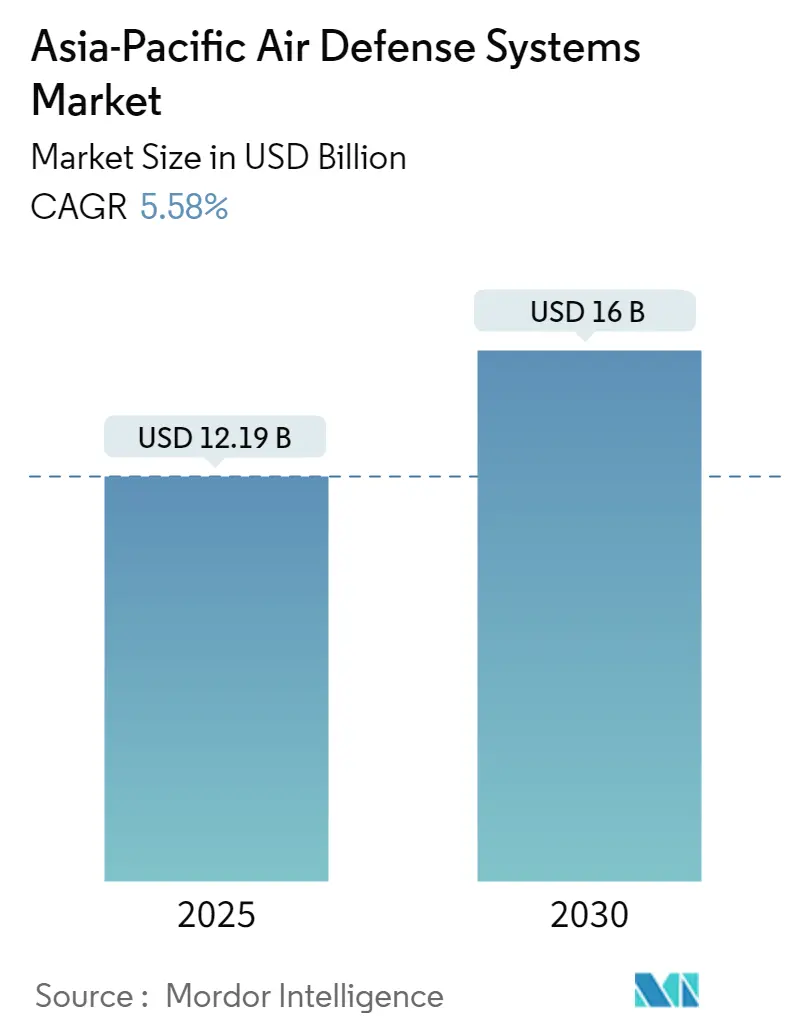
Asia-Pacific Air Defense Systems Market Analysis by Mordor Intelligence
The Asia-Pacific Air Defense Systems Market size is estimated at USD 12.19 billion in 2025, and is expected to reach USD 16.00 billion by 2030, at a CAGR of 5.58% during the forecast period (2025-2030).
Recent years have witnessed a transformation in air-based warfare, marked by the emergence of lethal, agile, and often untraceable autonomous threats. In response to these escalating threats, nations worldwide are intensifying efforts to fortify their air defense capabilities. Heightened geopolitical conflicts and border tensions have led countries to boost military spending, channeling significant investments into air defense systems. This surge in military expenditure is, in turn, fueling the demand for air defense systems in the Asia-Pacific region.
Technological advancements, especially the rise of sophisticated threats like hypersonic missiles, underscore the urgent need for enhanced air defense systems. In response, companies are innovating and developing advanced detection and countermeasure systems to address threats from UAVs, aircraft, missiles, rockets, artillery, and mortars.
Yet, the market faces challenges: high R&D costs and extended development cycles make players vulnerable to global economic fluctuations.
Asia-Pacific Air Defense Systems Market Trends and Insights
Land Segment to Witness Highest Growth During the Forecast Period
The land segment currently leads the market and is projected to maintain its position throughout the forecast period. Rising defense expenditures in major countries, including China, India, Japan, and South Korea, drive the demand for this segment. For example, in 2023, defense spending from China, India, Japan, South Korea, and Australia constituted 88% of the region's total. These nations, alongside others in the region, are enhancing their defense capabilities in response to threats such as ballistic and cruise missiles, aircraft, UAVs, rockets, artillery, and mortars.
In a notable move, India announced in November 2023 its procurement of Igla-S hand-held anti-aircraft missiles from Russia, emphasizing its commitment to bolstering combat capabilities. The Igla, a man-portable air defense system (MANPADS), is adept at targeting enemy aircraft and helicopters.
Several countries in the region are developing advanced, indigenously made land-based air defense systems to address geopolitical threats from neighboring nations. Taiwan, for instance, declared in November 2023 that it had commenced mass production of its advanced TC-2 air defense system. This short-to-medium-range system is set to bolster Taiwan's defenses, with plans to integrate 246 Sky Sword II air defense missiles. Designed as a land-based countermeasure, the TC-2 aims to neutralize threats from China's aircraft, drones, and cruise missiles. Such regional investments underscore a commitment to border protection, fueling the market's growth during the forecast period.
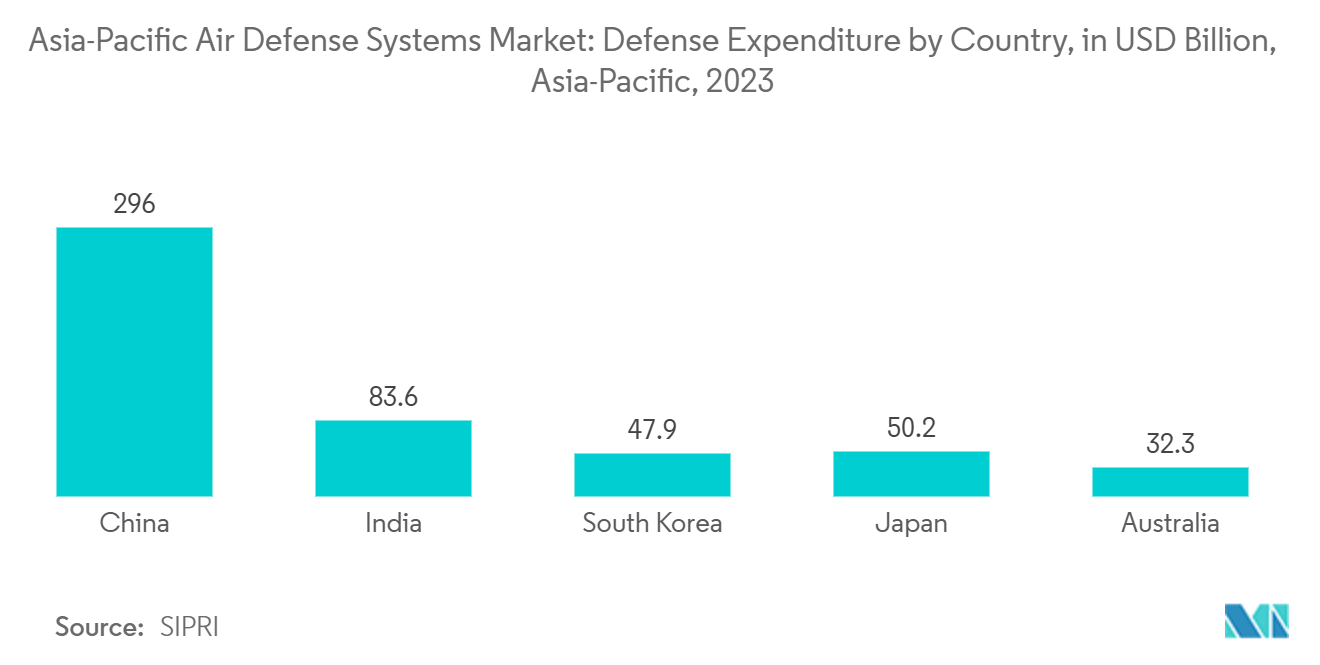
China is Expected to Witness the Highest CAGR During the Forecast Period
China is poised to lead the growth of the regional air defense market during the forecast period. Geopolitical tensions and border disputes with neighboring countries drive China's military investments, particularly in advanced air defense systems.
As the top defense spender in the Asia-Pacific, China allocated USD 296 billion to military spending in 2023, marking a 6% increase from 2022. China's military spending aligns with the 14th Five-Year Plan (2021–2025), emphasizing the development of advanced weaponry, including high-energy laser systems designed to intercept aerial threats.
In August 2023, the National University of Defense Technology revealed its endeavor to create an indefinitely operable laser weapon. If realized, these high-powered lasers could revolutionize warfare, targeting drones, missiles, and small aircraft at near-light speeds and lower costs than traditional interceptor missiles. Furthermore, in November 2022, China South Industries Group Corporation (CSGC) and China North Industries Group Corporation unveiled the Type 625E AA Gun Missile Integrated Weapon System, a short-range air-defense system adept at detecting low-flying threats like drones. Such advancements are set to drive the market's growth.
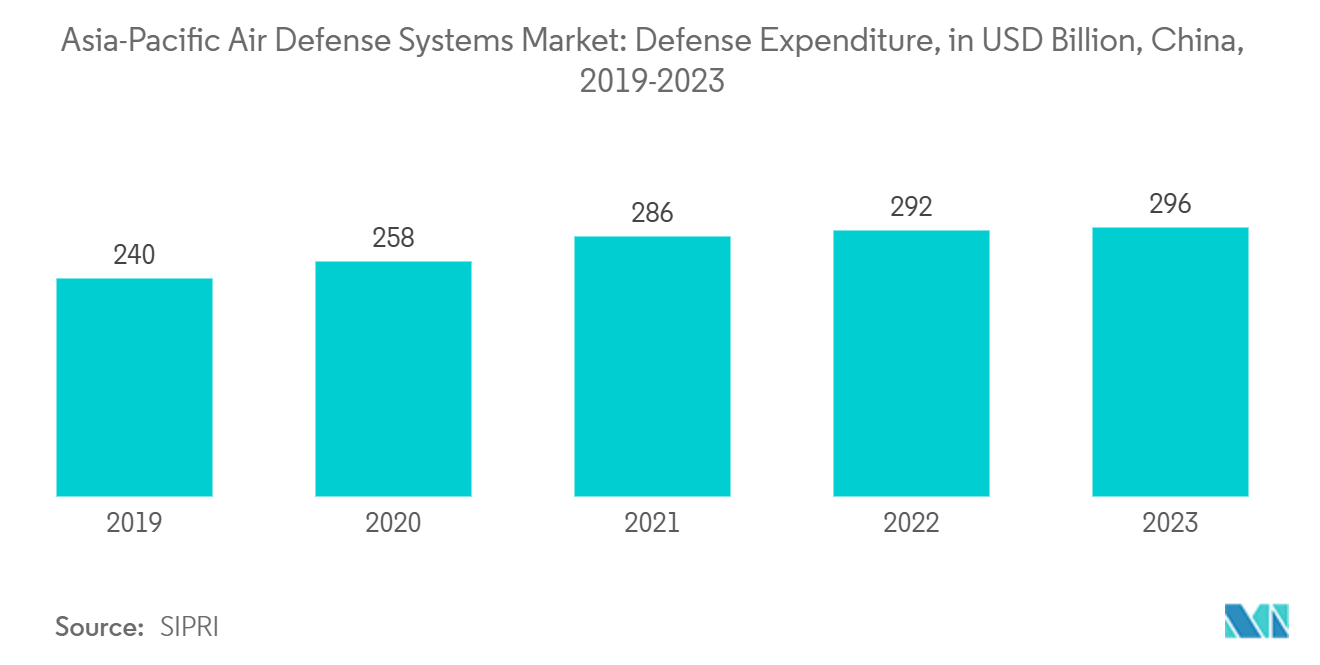
Competitive Landscape
The Asia-Pacific air defense systems market is semi-consolidated, and both local and international players offer diverse air defense solutions. Key players include Almaz-Antey Corp., IAI, RTX Corporation, Leonardo S.p.A, and Hanwha Systems Co., Ltd.
Regional players are poised to capture a larger market share in the coming years, bolstered by government investments to foster local manufacturing. For example, in India, the Defence Research and Development Organization (DRDO) spearheads the indigenous development of a multi-layered ballistic missile defense system under the Indian Ballistic Missile Defense Program. Furthermore, companies are channeling significant investments into R&D to bolster their market presence, focusing on advanced air defense systems equipped with enhanced detection and countermeasure capabilities.
Asia-Pacific Air Defense Systems Industry Leaders
RTX Corporation
IAI
Almaz-Antey Corp.
Hanwha Systems Co., Ltd.
Leonardo S.p.A
- *Disclaimer: Major Players sorted in no particular order
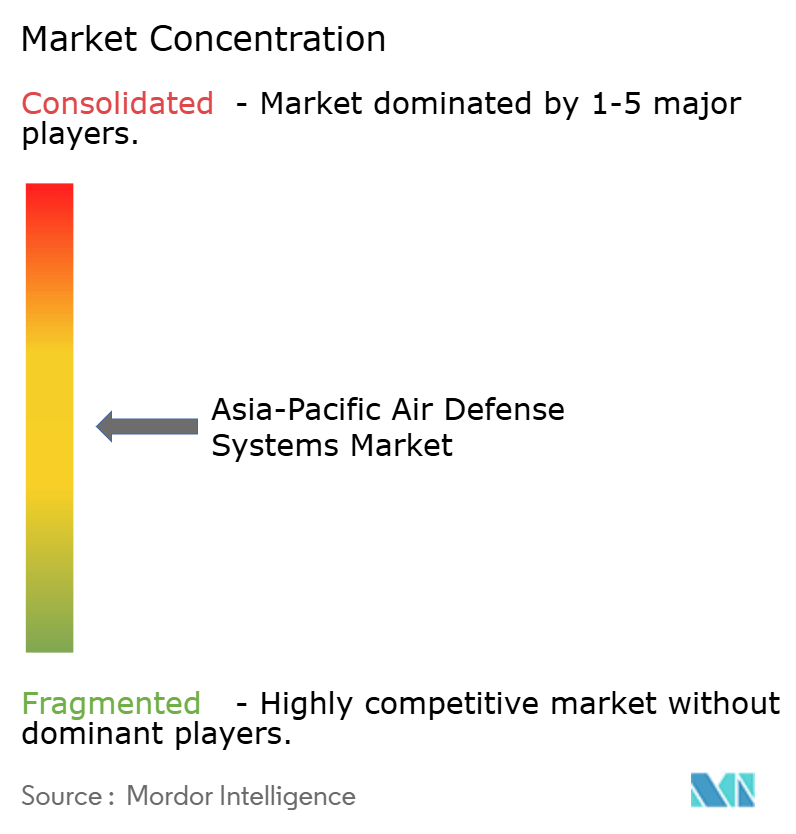
Recent Industry Developments
- April 2024: The Australian Department of Defence (DoD) awarded a contract worth AUD 500 million (USD 337 million) to Lockheed Martin Australia. This contract is for the delivery of Australia's future Joint Air Battle Management System, part of Project AIR6500 Phase 1 (AIR6500-1). Additionally, the DoD highlighted that AIR6500-1 will incorporate four advanced air-defense radars, manufactured by CEA Technologies, based in Canberra. The first of these radars is anticipated to be delivered in 2024.
- March 2023: Mitsubishi Heavy Industries (MHI) and Kawasaki Heavy Industries (KHI) unveiled the prototypes of their respective laser systems to shoot down incoming hostile unmanned aerial vehicles (UAVs) at the DSEI Japan 2023 show.
- February 2023: India’s DRDO announced that it had developed a very short-range air-defense system (VSHORADS), missiles, and a man-portable air defense system (MANPADS). The DRDO also mentioned that it had commenced the testing of this weapon system.
Asia-Pacific Air Defense Systems Market Report Scope
Air defense systems include all the radars and interceptors used by air, land, and sea platforms to detect and destroy incoming threats of missiles (ballistic and cruise), aircraft, UAVs, rockets, artillery, and mortars. The study also includes MANPADs, pedestal-mounted MANPADs, and remote weapon stations that can defend against incoming airborne threats by automatically tracking, targeting, and firing.
The Asia-Pacific air defense systems market is segmented by platform, range, and geography. By platform, the market is segmented into land-based, air-based, and sea-based. By range, the market is segmented into long-range, medium-range, and short-range. The report also offers the market size and forecasts for five countries across the region. For each segment, the market sizing and forecasts have been done based on value (USD).
| Land-based |
| Air-based |
| Sea-based |
| Long-range |
| Medium-range |
| Short-range |
| China |
| India |
| Japan |
| South Korea |
| Australia |
| Rest of Asia-Pacific |
| Platform | Land-based |
| Air-based | |
| Sea-based | |
| Range | Long-range |
| Medium-range | |
| Short-range | |
| Geography | China |
| India | |
| Japan | |
| South Korea | |
| Australia | |
| Rest of Asia-Pacific |
Key Questions Answered in the Report
How big is the Asia-Pacific Air Defense Systems Market?
The Asia-Pacific Air Defense Systems Market size is expected to reach USD 12.19 billion in 2025 and grow at a CAGR of 5.58% to reach USD 16.00 billion by 2030.
What is the current Asia-Pacific Air Defense Systems Market size?
In 2025, the Asia-Pacific Air Defense Systems Market size is expected to reach USD 12.19 billion.
Who are the key players in Asia-Pacific Air Defense Systems Market?
RTX Corporation, IAI, Almaz-Antey Corp., Hanwha Systems Co., Ltd. and Leonardo S.p.A are the major companies operating in the Asia-Pacific Air Defense Systems Market.
What years does this Asia-Pacific Air Defense Systems Market cover, and what was the market size in 2024?
In 2024, the Asia-Pacific Air Defense Systems Market size was estimated at USD 11.51 billion. The report covers the Asia-Pacific Air Defense Systems Market historical market size for years: 2019, 2020, 2021, 2022, 2023 and 2024. The report also forecasts the Asia-Pacific Air Defense Systems Market size for years: 2025, 2026, 2027, 2028, 2029 and 2030.
Page last updated on:
Asia-Pacific Air Defense Systems Market Report
Statistics for the 2025 Asia-Pacific Air Defense Systems market share, size and revenue growth rate, created by Mordor Intelligence™ Industry Reports. Asia-Pacific Air Defense Systems analysis includes a market forecast outlook for 2025 to 2030 and historical overview. Get a sample of this industry analysis as a free report PDF download.
